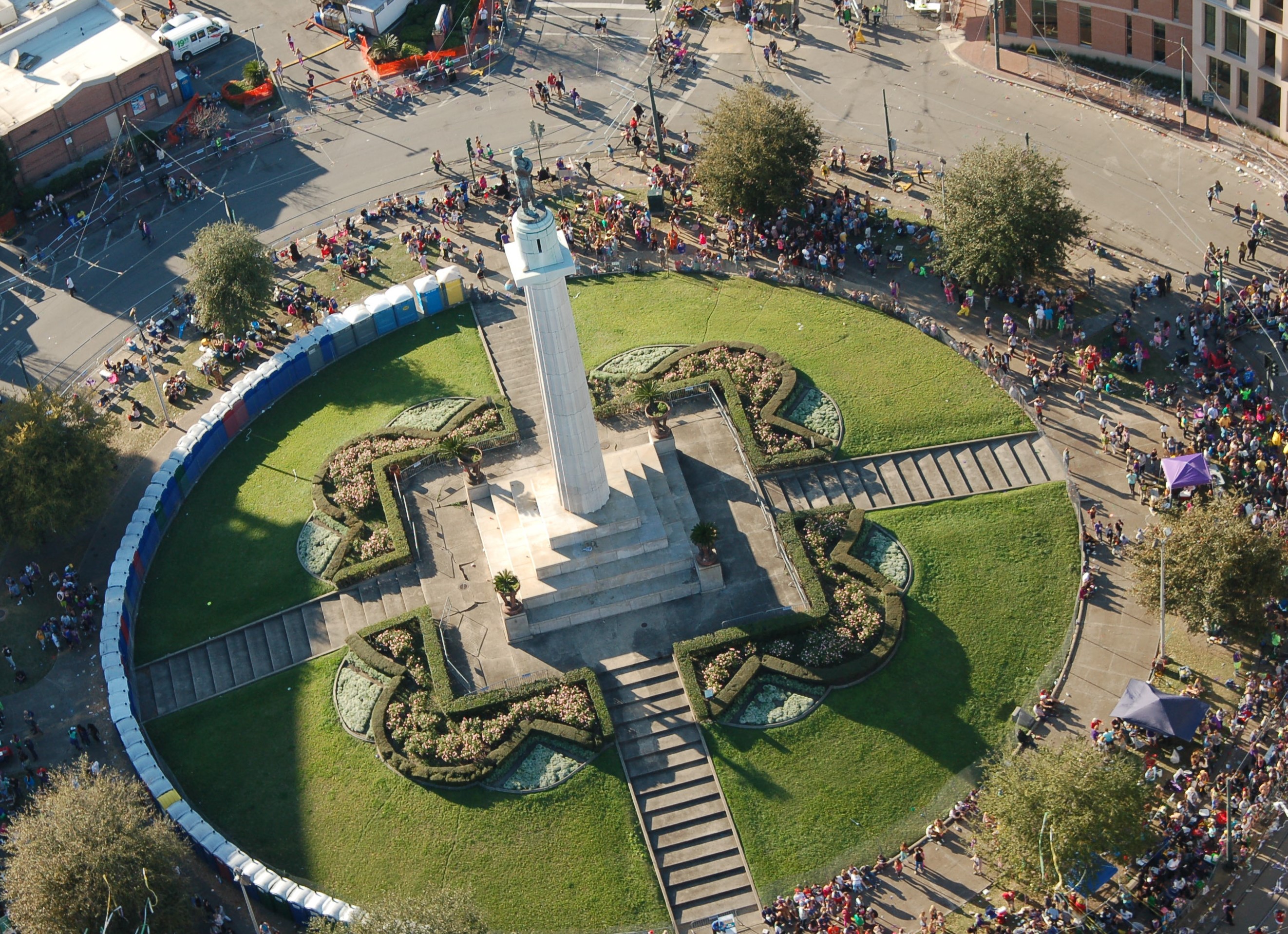
Part 1. Supporting the proposal for a Victory Circle in New Orleans to Honor all Americans
Each side of the steps to honor: Missing in Action (MIA), Purple Heart, Prisoners of War, and Gold Star Families
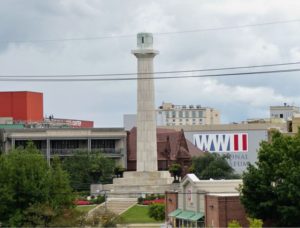
Please sign the petition and help us show the New Orleans Mayor and City Council the public support for having a Victory Circle in New Orleans.
Link to sign petition to show support for New Orleans Victory Circle
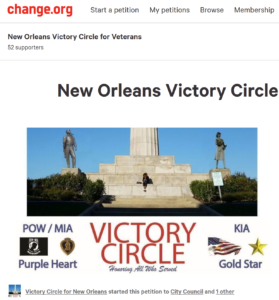
Orginal Proposal August 18, 2018, Revised October 17, 2018
Updated May 24, 2019
Quadrants to be dedicated to the Wars of American History
Eight statues with representative flags on the steps representing all branches and all races
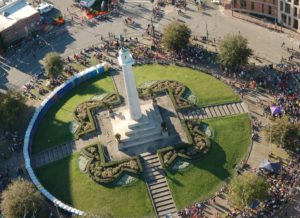 The top could be left empty or a statue to the Goddess of Freedom.
The top could be left empty or a statue to the Goddess of Freedom.
Numerous Cities along the Blue Star highway in Louisiana, from Monroe to the Gulf of Mexico, have some type of Victory Circle. New Orleans does not.
Pointe Coupee, Louisiana
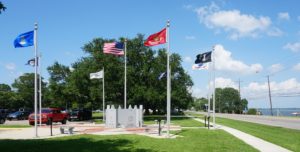
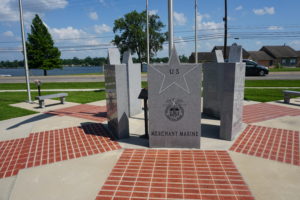
Veterans Square in Jefferson Parish
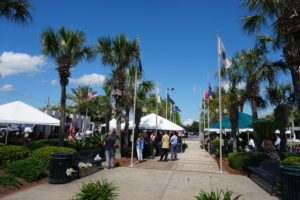
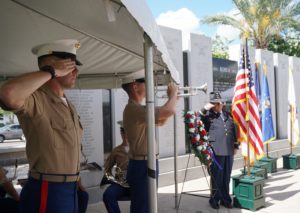
Peace Memorial Circle in Franklin
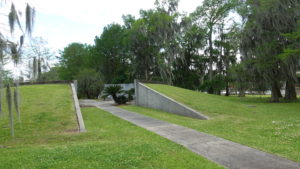
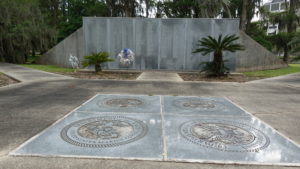
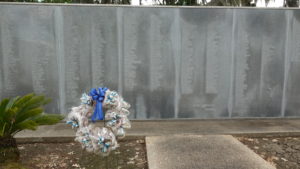
Drone Video of Victory Circle
Part 1. Annual Events for Victory Circle
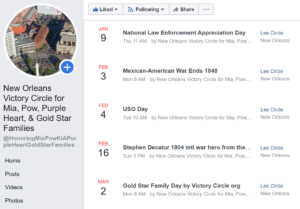
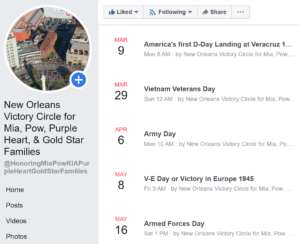
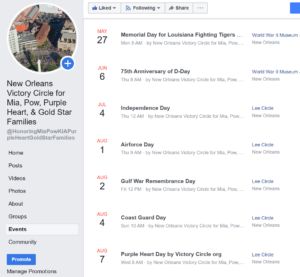
Part 2. The specific proposal for Victory Circle to Honor all Americans
In 1889 Vicksburg, Mississippi began adding to a Confederate Memorial, far left in picture, to create a space in downtown to honor all soldiers of all wars. A rose garden is incorporated into the memorial.
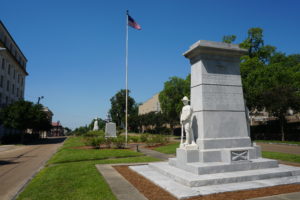
Please sign the petition and help us show the New Orleans Mayor and City Council the public support for having a Victory Circle in New Orleans.
Link to sign petition to show support for New Orleans Victory Circle
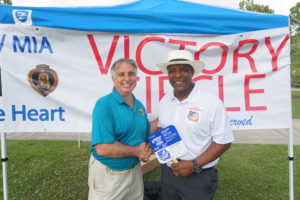
Updated May 24, 2019
The top could be left empty or a statue to the Goddess of Freedom.
The circle combines the concepts of the American Battle Monuments Commission with Arlington National Cemetery and the New Orleans World War II Museum
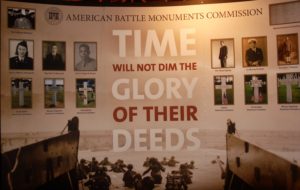
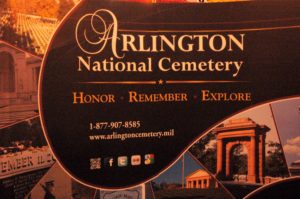
Arlington National Cemetery final resting to 400,000 service men and women of all wars.
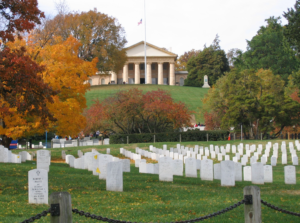
200-foot-tall Memorial in France to Americans KIA in World War I.
This proposal demonstrates the similarity between The World War I Montfaucon American Monument and the column and theme at Victory Circle.
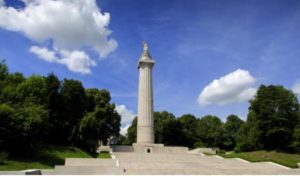
The World War I Montfaucon American Monument is located 20 miles northwest of Verdun, France. It consists of a massive granite doric column, surmounted by a statue symbolic of liberty. It commemorates the American victory during the Meuse-Argonne Offensive. There are twenty-nine cemeteries overseas which are the final resting to 130,000 service men and women.
The Goddess Liberty is a possible suggestion for atop the column.
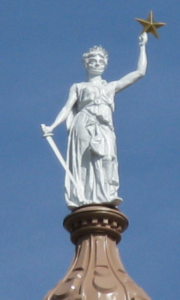
Some have suggested the top of the pedestal be left empty, similar to the Tomb of the Unknown Soldier. Others have suggested an eagle.
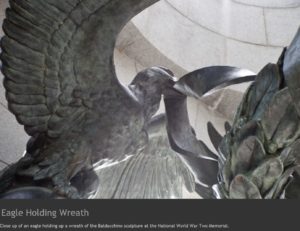
Up to eight statues with different races, sexes, and military branches on the corners of the steps. Two statues are facing each direction. The flags of the branches would be behind the statues.
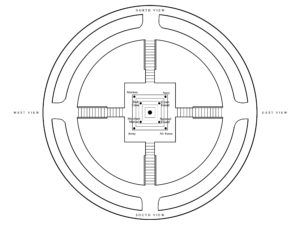
Missing in Action and Prisoner of War facing Downtown
The Gardens of Victory will be Dedicated to the Wars of specific Time Periods
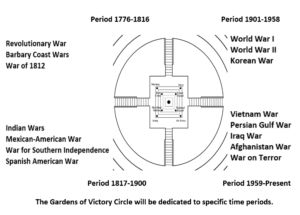
The Eight Statues represent the Branches of the Military, the Merchant Marines, and Military Support Organizations
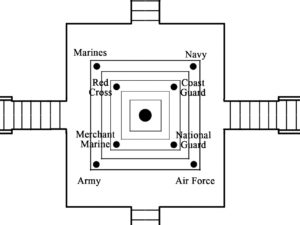
Sixteen to Twenty-Four Plaques are Proposed, four to six on each side.
Note: Plaques can be edited and added or subtracted. This proposal is meant to start as a template for input and collaborative design. Part of our motivation to go public is the 100th Anniversary of the World War I Armistice, November 11, 1918 at 11:00am. Which is also the Birthday of General George Patton.
The Poppy Flower is the symbol for those lost in action in WWI. The VFW sponsors Poppy Display Competitions at its annual conferences.
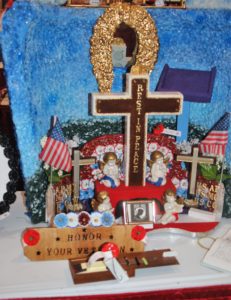
Plaque one:
Victory in War is a collaborative effort. The first major victory in New Orleans as an American State was on January 8, 1815 against the over 9,000 British in Chalmette, Louisiana. The victory was a result of numerous entities coming together. At the time New Orleans had the largest population of free people of color. However, United States law prohibited them from fighting. Andrew Jackson petitioned Governor Claiborne to allow them to fight to defend the America. In 1840, it was decided to erect a monument in Chalmette at the battlefield site. The monument was not finished until 1908 and contains a marker honoring the 450 free men of color who fought in the successful battle against the British.
African-American soldiers served on both sides during the War for Southern Independence, in the Buffalo Soldier Calvary Units during the Indian Wars of the 1870s, in World War I as the 92nd Infantry Division, and as Tuskegee Airmen in WWII.
Executive Order 9981 issued on July 26, 1948, by President Harry S. Truman abolished discrimination "on the basis of race, color, religion or national origin" in the United States Armed Forces.
Plaque Two:
During World War II, approximately 400,000 U.S. women served with the armed forces. As many as 543 died in war-related incidents, including 16 from enemy fire - even though U.S. political and military leaders had decided not to use women in combat because they feared public opinion. They included the Women's Airforce Service Pilots formed in 1943, who on March 10, 2010, were awarded the prestigious Congressional Gold Medal. The Women's Army Corps (WAC) and Women's Army Auxiliary Corps (WAAC) were the women's branch of the United States Army. The United States Naval Reserve (Women's Reserve), better known as the WAVES for the Women Accepted for Volunteer Emergency Service, was the World War II women's branch of the United States Naval Reserve.
By 1948 women were finally recognized as a permanent part of the U.S. armed forces with the passage of the Women's Armed Services Integration Act of 1948.
Plaque Three:
Philip Johnston, a civil engineer for the city of Los Angeles, proposed the use of Navajo to the United States Marine Corps at the beginning of World War II. Johnston, a World War I veteran, was raised on the Navajo reservation as the son of a missionary to the Navajo. He was one of the few non-Navajo who spoke the language fluently. Some Marines wondered whether the Navajo, who had been treated poorly by the US government, would want to fight for the U.S. But the Navajo dutifully enlisted shortly after Pearl Harbor and were eager to contribute to the war effort. "What happened to the Navajo were social conflicts," Navajo Code Talker Albert Smith said. "But this conflict involved Mother Earth being dominated by foreign countries. It was our responsibility to defend her.
The Navajo code talkers were commended for the skill, speed, and accuracy they demonstrated throughout the war. At the Battle of Iwo Jima, Major Howard Connor, 5th Marine Division signal officer, had six Navajo code talkers working around the clock during the first two days of the battle. These six sent and received over 800 messages, all without error. Connor later stated, "Were it not for the Navajos, the Marines would never have taken Iwo Jima.
Plaque Four:
On September 11, 2001 America was attacked by terrorists. The World Trade Center attack resulted in 2,996 deaths and caused at least $10 billion in infrastructure and property damage. Of those killed were 344 firefighters and 71 law enforcement officers.
Daily across America thousands of first responders and public safety employees work to keep American Citizens safe domestically.
First responders are America’s Army in the domestic war on opioids, both to stop the organizations that profit from drug dealing and to save the lives of the victims of drug overdoses.
Plaque Five:
Founded in 1941, The United Service Organizations Inc. (USO) is a nonprofit organization that provides live entertainment, such as comedians and musicians, and other programs to members of the United States Armed Forces and their families. It has worked in partnership with the Department of War, and later with the Department of Defense (DoD), relying heavily on private contributions and on funds, goods, and services from various corporate and individual donors.
USO Warrior Weeks provide opportunities for wounded, ill, and injured service members to participate in various therapeutic and recreational activities in hopes to aid in their recovery.
The USO has over 200 locations around the world in 14 countries (including the U.S.) and 27 states. It is estimated that the USO has served more than 35 million Americans over its history.
Plaque Six:
The United States Merchant Marine refers to either United States civilian mariners, or to U.S. civilian and federally owned merchant vessels. Both the civilian mariners and the merchant vessels are managed by a combination of the government and private sectors, and engage in commerce or transportation of goods and services in and out of the navigable waters of the United States
The first wartime role of an identifiable United States Merchant Marine took place on June 12, 1775, in and around Machias, Massachusetts. A group of citizens, hearing the news from Concord and Lexington, captured the British schooner HMS Margaretta. The citizens, in need of critical supplies, were given an ultimatum: either load the ships with lumber to build British barracks in Boston, or go hungry. They chose to fight.
The merchant marine was active in subsequent wars, from the Confederate commerce raiders of the American Civil War, to the assaults on Allied commerce in the First and in the Second World Wars. 3.1 million tons of merchant ships were lost in World War II. Mariners died at a rate of 1 in 26, which was the highest rate of casualties of any service. All told, 733 American cargo ships were lost and 8,651 of the 215,000 who served perished.
Plaque Seven:
The Veterans of Foreign Wars of the United States (VFW) is an American war veterans organization headquartered in Kansas City, Missouri. The VFW was established in 1899. The organization's membership consists of veterans who, as soldiers, sailors, marines, airmen, and coast guardsmen served the United States.
The VFW speeds rehabilitation of the nation's disabled and needy veterans, assist the dependents of needy or disabled veterans, and promote Americanism by means of education in patriotism and by constructive service to local communities.
The United Daughters of the Confederacy (UDC) was established in 1894 to care for soldiers and their graves from the War for Southern Independence. UDC efforts expanded to include erecting monuments to promote patriotism and civic duty. The UDC evolved from the Ladies Soldiers Aid Societies (LSAS) during the war that were dedicated to providing supplies to soldiers on the battlefield and caring for sick and wounded soldiers.
The LSAS organized a multi-state Decoration Day for the graves of both Union and Confederate soldiers on April 26, 1866. This became an annual tradition and is viewed by many as the beginning of annual Memorial Day celebrations. In New Orleans, the UDC financially supported and contributed to the Camp Nicholls Veterans’ home from 1884-1932.
Plaque Eight:
During World War I, the Knights of Columbus supported the war effort and the troops. The order established soldiers' welfare centers in the US and abroad. The organization had provided similar services to troops encamped on the Mexican border during General Pershing's expedition of 1916. With the slogan "Everyone Welcome, Everything Free," the "huts" became recreation & service centers for doughboys regardless of race or religion. The huts were staffed with men generally past the age of military service. Following the war, the Knights promoted domestic efforts aimed at reducing racism with the theme of “Unity, Charity, and Patriotism.” In 1937, President Roosevelt declared Columbus Day a national holiday in appreciation of the Knights of Columbus efforts.
Regionally and nationally numerous organizations have evolved in modern times to support military efforts and service care for veterans.
Plaque Nine:
This site was used to frequently honor more than 11,000 men who did not return home to Louisiana and were either Killed in Action or Missing in Action following the 1861-1865 War for Southern Independence. The men were known as “Lee’s Tigers,” for their tenacity. When their ammunition expired at the Battle of Second Manassas, they refused to retreat and held a supply bridge. The Tigers held their ground by throwing rocks as they had run out of bullets. The confused Union Army retreated and allowed Confederate re-enforcements to arrive. The Louisiana State University Mascot is named after “Lee’s Tigers.”
The site was originally proposed in 1870 and completed in 1884 for the World’s Exposition held in New Orleans at Audubon Park. At that point in time the area West of this circle was sparsely developed. A 16’ tall statue of Robert E. Lee, who was in the U S Army for over 30 years, was placed on top of the column due to his contributions to Louisiana and America and to provide a memorialization to “Lee’s Tigers.” It was dedicated three weeks after a Veterans Home on Bayou St. John.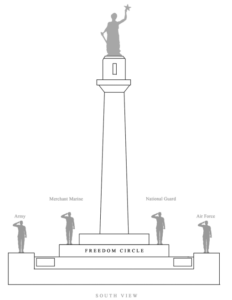
Plaque Ten:
Lee’s contributions to America and Louisiana include:
1837-1841 Lee was a U S Corps Engineer in charge the Upper Mississippi River Valley and known as “The Man who Tamed the Mississippi,” when he saved St. Louis as a port as the river was moving to the Illinois side.
1846-1848 Mexican-American War. Lee left from Jackson Barracks in New Orleans and was responsible for the landing of 12,000 men and 80 ships on March 9, 1847 at Veracruz Beach, the 250-mile march to Mexico City, and the siege of “The Halls of Montezuma.” From 1852-1854 Lee was Superintendent of West Point.
Lee was a base commander stationed in Texas. In 1857 Lee wrote to his wife: “Slavery as an institution is a Moral and Political Evil.” In January 1861, when Texas seceded, he negotiated his release from the Confederates and boarded a steamer to New Orleans. This likely made him the first Union Officer in Louisiana after secession.
Lee’s civil engineering efforts developed the land gains from both the Louisiana Purchase and Mexican-American War which benefitted the economy of New Orleans. From 1866-1870, he was President of Washington University, where he opened the nation’s first school of journalism. His engineering studies of the Mississippi River were used for decades.

Plaque Eleven:
In April 1861, Virginia voted to stay in the Union. However, by mid-April it was clear Abraham Lincoln was putting forth a large-scale military action and asked Robert E. Lee to lead an army of 75,000 men through Virginia to put down the rebellion in South Carolina. Lee believed a state had the right to refuse access by Federal Troops and thus supported the Governor of Virginia and resigned after thirty-four years in the U S Army. In mid-April, aware of the pending invasion, the Virginia legislature reversed its vote and left the Union. In the following months the states of Arkansas, Missouri, Kentucky, North Carolina, and Tennessee would also leave the Union over the state’s right to refuse to participate in the war.
Lee’s Veracruz landing and march to Mexico City in 1847 were studied by General Eisenhower for the D-Day Landing of June 6, 1944. President Eisenhower hung portraits of George Washington, Ben Franklin, Abraham Lincoln and Robert E. Lee in the oval office. President Eisenhower initiated and signed the 1957 and 1960 Civil Rights Acts.
Plaque Twelve:
Killed in Action: America has experienced numerous days in which thousands have been killed in one battle and been involved in several multi-years wars with tens of thousands Killed in Action. Often those killed were buried where they died and as with the “Lee’s Tigers” their loved ones have no grave to visit. During the conflict from 1861-1865 tens of thousands of soldiers were buried away from home.
Following World War I, the American Battle Monuments Commission (ABMC) was formed for the construction of monuments honoring the American Expeditionary Forces. As of 2018, there were 26 permanent American military cemeteries and 29 federal memorial monuments and markers are located in 16 foreign countries.
Hundreds of thousands of soldiers were buried during the 1800s from their homes. Nearby in Chalmette Louisiana over 10,000 Union Soldiers are buried. During the 1800s thousands of soldiers, including many known as the Buffalo Soldiers, died in battles known as the Indian Wars. Conditions at the time required burial on the battlefield. Victory Circle honors the soldier and does not judge the merits of any war.
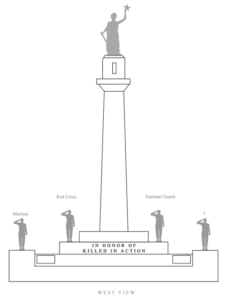
Plaque Thirteen:
Killed in Action: Of the 124,000 American war dead interred in foreign cemeteries 30,973 are from World War I, 93,202 from World War II, and 750 from the Mexican-American War.
Missing in Action: More than 94,000 American servicemen and women are missing in action, lost, or buried at sea from World War I, World War II, the Korean War and the Vietnam War. The cemetery at Normandy Beach is the resting place to 9,387 Americans.
In 2009, U.S. President Barack Obama designated the last Sunday in September as Gold Star Mothers' and Families' Day. Flags were flown by families during World War I of Gold Star families. Just after World War I, the Gold Star Mother's Club was formed.
The Purple Heart was first created on August 7, 1782 by the commander-in-chief of the Continental Army, General George Washington. The "Military Order of the Purple Heart," was formed in 1932.
Plaque Fourteen:
The 1884 bronze of Lee was sculptured by Alexander Doyle (1857–1922). Doyle was born in Steubenville, Ohio, and spent his youth in St. Louis Missouri before going to Italy to study sculpture in Bergamo, Rome, and Florence, with Giovanni Duprè, Carlo Nicoli and Fernando Pelliccia. He was a member of the Royal Raphael Academy.
After returning to the United States, he settled in New York City and became one of the most prominent sculptors of the era. His work can be found throughout the United States. A Doyle marble-depiction statue of Margaret Haughery, a New Orleans woman who devoted her life to the poor, was erected in 1889, the first monument to honor a female philanthropist in the United States.
The “Alexander Doyle Papers, 1852-1937” are located in the Smithsonian Institution’s Archives of American Art in Washington D.C.

Plaque Fifteen:
During the 100th Anniversary of the 1918 World War I Armistice and with the tremendous success of the World War II Museum, New Orleans rededicated this land as “Victory Circle” in honor of all Americans Killed in Action and Missing in Action. In this manner, the memorial to “Lee’s Tigers” was not desecrated.
The 60’ column is reminiscent to the 200’ tall column of the World War I Montfaucon American Monument located seven miles south of the Meuse-Argonne American Cemetery and Memorial and 20 miles northwest of Verdun, France. That column is surmounted by a statue symbolic of liberty. Over 80,000 people from Louisiana participated in The Great War.
In 1944, Andrew Higgins of New Orleans designed the landing craft for D-Day invasion on the Normandy Beaches of France. General Dwight Eisenhower is quoted as saying, "Andrew Higgins ... is the man who won the war for us. The word “Victory” became the objective for America and was used frequently to describe ships, bonds, and numerous other items.
Plaque Sixteen:
The 2018 opportunity was taken to create Victory Circle as a racial and gender inclusive site.
by adding eight statues to represent the different branches of the U S Military, the USO, and Merchant Marines with various genders and nationalities portrayed in the sculptures.
During the War for Southern Independence, Robert E. Lee’s estate was turned into a burial ground for soldiers. Today Arlington National Cemetery is the final resting place for over 400,000 soldiers. Arlington is home to the Tomb of the Unknown Soldier.
Just as Robert E. Lee’s home was transformed to Arlington National Cemetery, in 2018 the residents of New Orleans came together to honor all those seeking to honor the nation’s military who were never given a U S Burial by converting the memorial to “Lee’s Tigers” to a memorial for the KIA, Gold Star, Purple Heart, and POW/ MIA of all wars.
Additional Plaques to consider:
Plaque Seventeen:
In April of 2015, Mayor Slay of St. Louis in response to pressure from an organization known as Black Life Matter opted to remove a statue located near a spot known as Camp Jackson where on May 10, 1861, Union soldiers massacred twenty-eight citizens including women and children. Missouri was a slave state. It legislature voted to remain in the Union by a 98-1 vote, but not participate in the war. The Union Army wanted lead from the Ozark Mountains for bullets. This event divided the state and led to a civil war in Missouri, with many citizens opting to fight for the South despite that fact that slavery was limited in Missouri. In 1914, the United Daughters of the Confederacy erected a monument to those men that enlisted, motivated by the Camp Jackson Massacre.
In June 2015, New Orleans Mayor Mitch Landrieu announced he wanted to remove four of the ten Confederate Monuments in New Orleans. He never explained why the six could remain, which included a Confederate Cannon on the Moonwalk. In 2017, Mitch Landrieu remodeled the Moonwalk, named after his father Moon Landrieu. During this time, a plaque was added honoring Mitch Landrieu.
Plaque Eighteen:
In New Orleans, for several years some residents and a couple of organizations wanted the statue of Robert E Lee removed. Their position was that even though Lee had a stellar U S Army Career of thirty years, had engineered the Mississippi River to develop New Orleans Commerce in the 1830s, and had factored greatly in the Mexican-American War effort to add six Western states; once Lee decided to remain loyal to the state of Virginia, Lee was a traitor to the United States.
Similar to Missouri, the Virginia legislature had initially voted to remain in the Union on April 4, 1861 with 66 out of 152 voting in favor of Secession. By April 12, 1861 word of President Lincoln’s decision to call-up a Union Army of 75,000 that would be marching into Virginia on its way to South Carolina to put down the rebellion spread. Virginia called a second vote. By April 17, 1861, Robert E. Lee had declined to lead the Union Army and Virginia had voted to secede.
As the Union made its way from Massachusetts to South Carolina, the first causalities of the war happened. Twelve anti-war protestors were killed by Union Troops in the Union state of Maryland on April 19, 1861. Four soldiers were killed, hundreds wounded on both sides.
Plaque Nineteen:
To many the cause of the war was slavery. The Republican Party had been formed in 1854 to abolish slavery and the election of its Presidential Candidate in 1860 caused seven Southern States to secede. Others argued that to win the election of 1860, the Northern Representatives in the House of Representatives passed the Morrill Tariff on goods the South was importing from Europe especially goods made from steel.
From 1816 through 1860, taxes on cotton were being used to build railroad infrastructure in the Louisiana Purchase newly acquired land from the Mexican-American War and not in southern states generating the revenue.
In 1832, South Carolina had argued that a state had the right to nullify any tax or tariff it thought unconstitutional or placing an unequal burden on that state. Andrew Jackson had threatened war on South Carolina during the Nullification Crisis and stated: “The Union Must be Preserved.” During the Union Occupation of New Orleans, General Benjamin Butler engraved those words on the Jackson Monument in Jackson Square.
Plaque Twenty:
The war in America was initially given several names. The South never sought control of the United States, rather it sought its Independence. The South sought to create a nation with limited Federal control or a “Confederacy.” The North desired greater Federal Control, this was a battle which had waged in America since the founding. Thus, the War in the South was called the War for Southern Independence. The North, which printed the text books, referred to the war as a “Civil” war, which is technically was not.
As the war progressed, President Lincoln first issued proclamations allowing Union Soldiers to take the possessions of Southerners in rebellion. Eventually this led to the Emancipation Proclamation, which only allied to areas in rebellion.
In 1866, the Republican Congress passed the 13th Amendment abolishing slavery in all states. The last state to end slavery was the Union State of Delaware on December 6, 1865 as mandated by the ratification of the 13th Amendment. However, in the second decade of the twenty-first century, many began to celebrate June 19, 1865 as the end of slavery in America, due to the fact it ended in Texas that day.
Plaque Twenty-One:
Before the war started, states elected delegates to state conventions. Most the popular votes were within a 55% to 45% on secession delegates versus constitution-union delegates. General Scott, who had offered Command of the Union Army to Robert E. Lee, suggested President Lincoln wait to invade South Carolina and attempt to resolve the situation with diplomacy.
On March 2, 1861 Congress passed the Corwin Amendment to encourage border states to remain in the Union. The amendment guaranteed a state’s constitutional right to continue slavery. Initially seven Southern states voted to secede. After the war began, six border states switched sides most due to opposing the Union Army’s march through their states.
During the war, the Union Army took a position to burn down the towns of the South. In Louisiana the town of Alexandria was burned from April 28 to May 13, 1864. Union General Sherman’s famous “March to the Sea” burned Atlanta and a fifty-mile wide path to the Atlantic Ocean. Sherman became head of the U S Army and used this same tactic on Native American in the Indian Wars.
Plaque Twenty-Two:
Tens of thousands of soldiers became War Wounded. Following the war, the Soldiers Aid Society and other organizations began building homes to care for veterans. The first to open in New Orleans was Camp Nicholls in February 1884. New Orleans continued to have large deaths due to Yellow Fever, with 4046 recorded in 1878. With businesses burned down, many wounded, and Yellow Fever, the years following the war, were a difficult time.
Still, New Orleans decided to host the 1884 the World's Industrial and Cotton Centennial Exposition. Just prior to the opening of the fair, the fourteen-year effort to erect a monument to Robert E. Lee was achieved with a forty-plus page dedication speech to “…the purity of his life, the moral of grandeur of his character, and the splendor of his achievements.”
Lee in the following years was praised by numerous United States Presidents and foreign leaders. President Dwight Eisenhower hung a portrait of Lee next to Lincoln, Washington, and Franklin in the Oval Office. When questioned about this, Eisenhower wrote: “From deep conviction, I simply say this: a nation of men of Lee’s calibre would be unconquerable in spirit and soul. Indeed, to the degree that present-day American youth will strive to emulate his rare qualities, including his devotion to this land as revealed in his painstaking efforts to help heal the Nation’s wounds once the bitter struggle was over, we, in our own time of danger in a divided world, will be strengthened and our love of freedom sustained.”
Plaque Twenty-Three:
In June 2015, New Orleans Mayor Mitch Landrieu announced he wanted to remove the statue of Robert E. Lee claiming Lee had never been to New Orleans, had fought to break-up the United States, that the monument had been put for the reason to promote White Supremacy over African-Americans, and to make a statement that in 1884 whites were still in charge in New Orleans.
That it was quickly discovered that Lee had been to New Orleans multiple times and perhaps the first Union Officer into New Orleans in February 1861. Landrieu never cited anything in the 1884 dedication speech, the minutes of the monument association, or newspaper articles of the time to support his claims.
Some have argued that when Lee resigned his U S Army Commission in 1861, he became a traitor to the United States and therefore there should be no mention of him moving forward on this memorial.
In May 2017, the statue was removed from the top of the column and placed in a wooden shed in a city vehicle repair yard. Landrieu left office in 2018, without resolving the issue of the circle, leaving it for Mayor LaToya Cantrell to resolve.
Plaque Twenty-Four:
Intentionally left blank
Flags representing Gold Star, Purple Heart, POW*MIA, and various branches would be placed behind their representative statue on the steps.
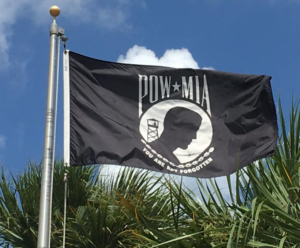
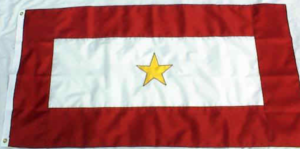
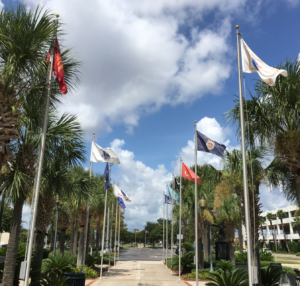
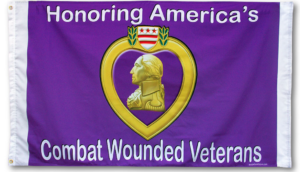
Conclusion and Opportunities
The proximity of Victory Circle to the World War II Museum provides an opportunity to add activities during Memorial Day, Veterans Day, and D-Day at the circle.
These activities could include:
- Unique to America, one spot to honor 130,000 KIA and MIA who are overseas
- Utilize the Marine Band stationed in Algiers to march from the Museum to the Circle. The Red Stripe on the Marines Uniform comes from the Battle the Lee designed at "The Halls of Montezuma."
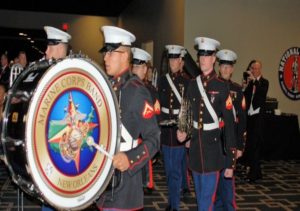
- Events to bring attention to the end of all the wars Americans have fought.
- Events to bring attention to all races and sexes that served in the Armed Forces.
- Events to honor the USO and Merchant Marines and non-enlisted that played a major part in the war efforts.
- Events to educate on the impact of the Battle of New Orleans with developing the Mississippi River and New Orleans as a great port of commerce for the United States.
- Events to educate on the role Jackson Barracks played as the launching place for the Mexican-American War and the value of the six additional states gained from that war.
- Events to honor the various branches of the military, such as their birthdays.
- Events to honor the Buffalo Soldiers, The Tuskegee Airmen, the WACS, the WAVES, the Navajo Code Talkers, and other groups who served America’s war efforts.
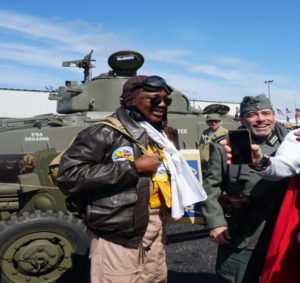
- Educational value for families and teachers to learn the history of America’s progressive evolution to freedom.
- Events with the Victory Bells of the World War II Museum.
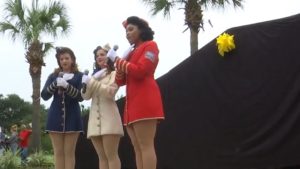
- Victory Circle would participate in the Vietnam War Commemoration
National Vietnam War Veterans Day is celebrated on March 29th, the day that the last of the troops were withdrawn in 1973.
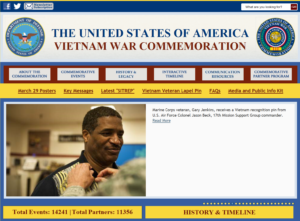
13. Stands for the military at Victory Circle during parade season
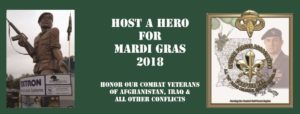
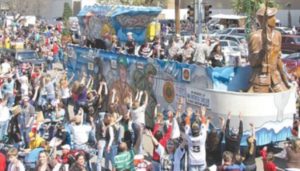
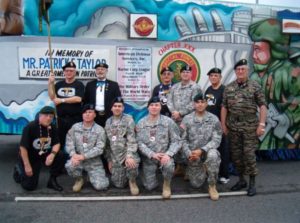
14. Gold Star Day is the last Sunday in September
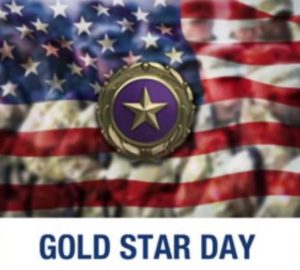
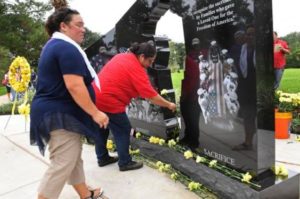
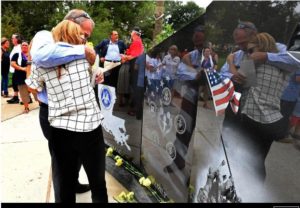
15. The Purple Heart was first created on August 7, 1782. August 7 remains Purple Heart Day
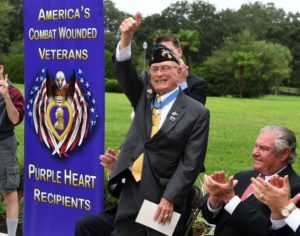
Questions and Concerns:
1. Why call it the “War for Southern Independence” as opposed to the “Civil War?”
The definition of Civil War is a war between citizens of the same country. A war of independence is a conflict occurring over a territory that has declared independence. Once the state that previously held the territory sends in military forces to assert its sovereignty or the native population clashes with the former occupier, a separatist rebellion has begun.
Examples are the Civil War in Syria versus the Catalonia War for Independence in Spain. In Syria different groups are fighting for control over the same land. In Spain the residents of Catalonia want their land declared Independent from Spanish Rule.
2. Why mention Robert E. Lee?
The fund raising for the monument was from 1870-1884 and motivated to honor the character and achievements of Robert E. Lee, who at the time of his death was working to mend a divided nation. Contrary to published statements Lee had been to New Orleans multiple times. Lee's 1841 Engineering of the Mississippi River expanded commerce for New Orleans. His battle plans in the Mexican-American War of 1847 added six Western States, whose commerce passed through the port of New Orleans.
3. Why mention the Louisiana Tigers?
The design of the memorial was a Tumulus. The 12,000 Louisiana Tigers fought under Lee from 1861-1865. Less than 400 returned home. The Tumulus memorial served as a grave site for descendants of these men to pay respects and still does.
4. Was the statue erected in 1884 to support Jim Crow Laws and racism?
No. Nothing has ever been produced to demonstrate that claim. It is hard to believe in times as tough as the 1870s, people were willing to donate their food and housing money for a fifteen-year project to send a message of racism. Rather the focus was raising every penny to care for war wounded. The Camp Nicholls Veterans Home opened two weeks before the dedication of the monument.
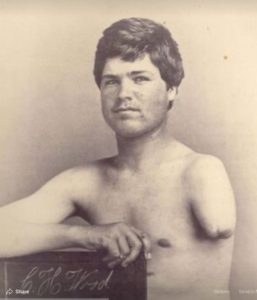
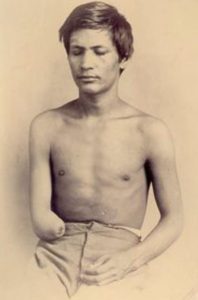
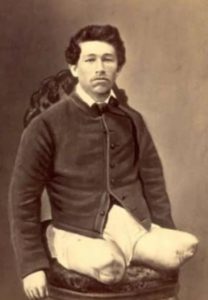
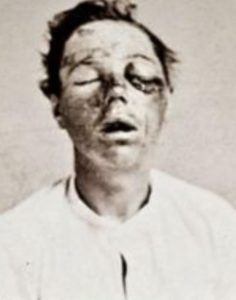
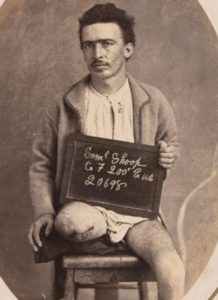
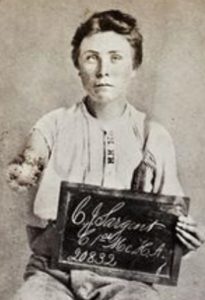
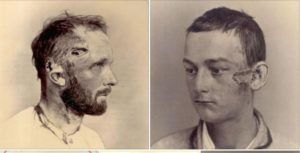
Historian Walter Isaacson when speaking at Newman School in New Orleans in 2017 noted the reasons were "noble" for erecting the monument.
Link to Video of Walter Isaacson explaining that Lee was put up for "Noble" Reasons
5. Were there any other issues causing the War in American of 1861 besides slavery?
- Yes: The Morrill Tariff proposed in 1860 to help Pennsylvania Steel Workers at the expense of Southern States trading cotton for steel with England
- States’ Rights on Banking and interest rates
- Could a state declare an unequal tax “Null and Void" as a violation of the Constitution?
- Was the Country going to have a strong Central Union Government or be a Confederacy of strong states
- Could the Federal Government march troops through a state without its permission? In 1878 Congress revised the Posse Comitatius Act to which prevented Presidents from repeating Abraham Lincoln's troop movements into objecting states and re-enforced a state's right to refuse Federal Troops on its land.
6. James Gill of The Advocate Paper asked "Does Lee belong in Victory Circle?"
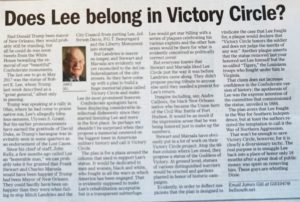
We believe he does for the following reasons: 1. Lee was the architect of America's Victory in the Mexican-American War which propelled New Orleans Commerce especially once the Transcontenttinal Railroad was built from San Francisco to New Orleans. 2. Lee was heavily involved in landing 80 ships and 12,000 men in Veracruz Mexico on March 9, 1847. General Eisenhower studied this landing for D-Day. 3. Lee's 1837-1841 engineering work on the Mississippi allowed war time goods to move freely on the Mississippi River Valley.
Gill's column does not address the title of the column as he decided to speak about Trump, Landrieu, David Duke, and the authors of the Victory Circle proposal rather than the role of Victory in the Mexican-American War in the development of New Orleans and America.
Part 3. Synergy of a Victory Circle in New Orleans
The World War II Museum has over 800,000 visitors per year. Parades could go to Victory Circle and easily return to the Museum.
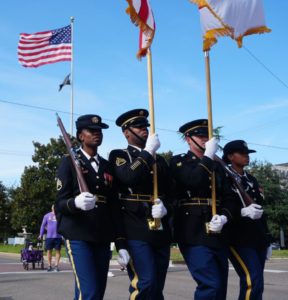
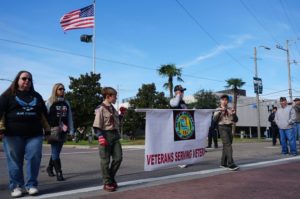
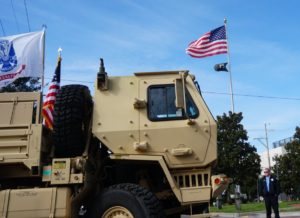
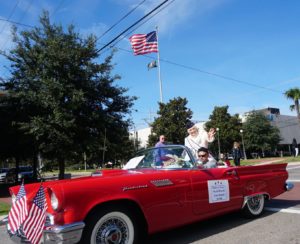
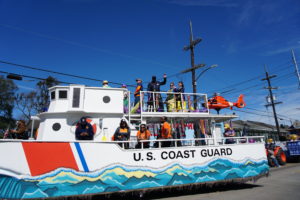
On May 23, 2019 the World War II Museum presented Colonel Charles Edward McGee of the Tuskegee Airmen a Silver Service Medallion as part of their American Spirit Awards.
He has written two books on his 30 years of active duty with 6,300 hours of flying. He is one of 10 remaining Tuskegee Airmen remaining.
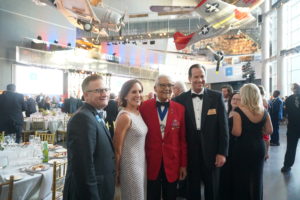
Colonel McGee will turn 100 on December 7, 2019.
*********************************************
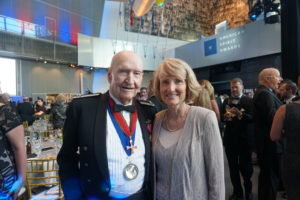
Colonel Gail Halvorsen began his career in 1941. In 1948 he became involved in the Berlin Airlift.
He is best known as the "Berlin Candy Bomber" or "Uncle Wiggly Wings" and gained fame for dropping candy to German children during the Berlin Airlift from 1948 to 1949.
Halvorsen piloted C-47s and C-54s during the Berlin airlift ("Operation Vittles"). During that time he founded "Operation Little Vittles", an effort to raise morale in Berlin by dropping candy via miniature parachute to the city's residents. Halvorsen began "Little Vittles" with no authorization from his superiors but over the next year became a national hero with support from all over the United States. Halvorsen's operation dropped over 23 tons of candy to the residents of Berlin. He became known as the "Berlin Candy Bomber", "Uncle Wiggly Wings", and "The Chocolate Flier".
****************************************
Let's start the victory circle project while we have members of the Greatest Generation with us. Please sign the petition.
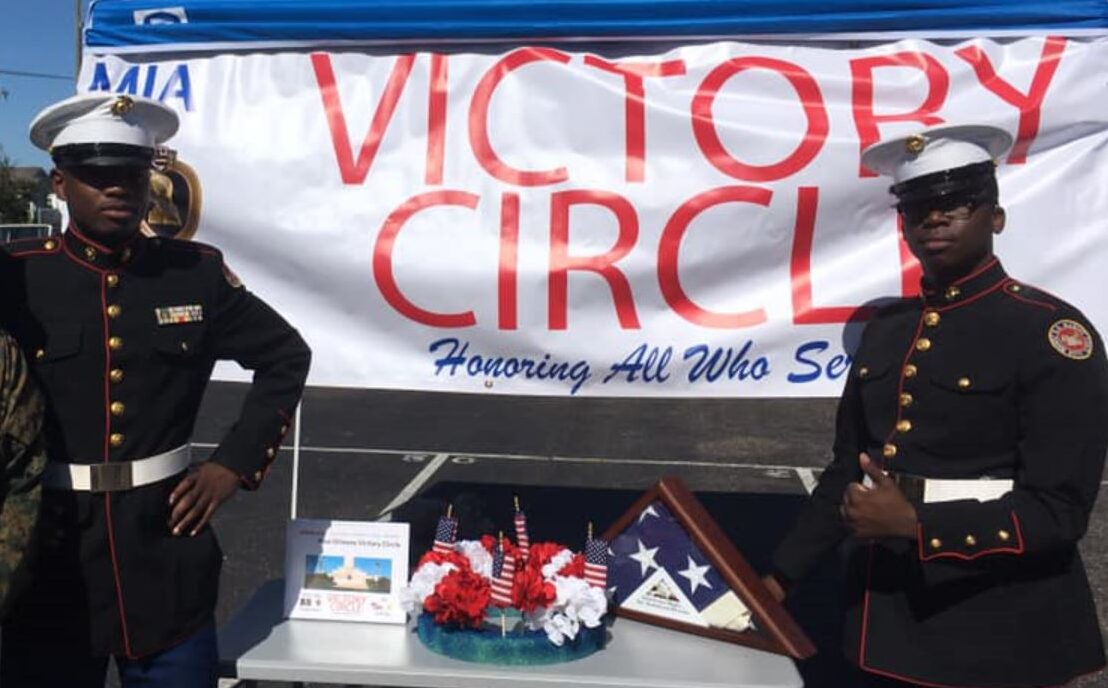
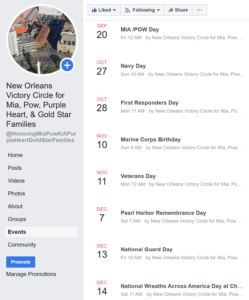
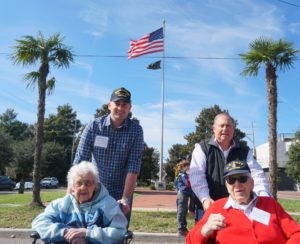
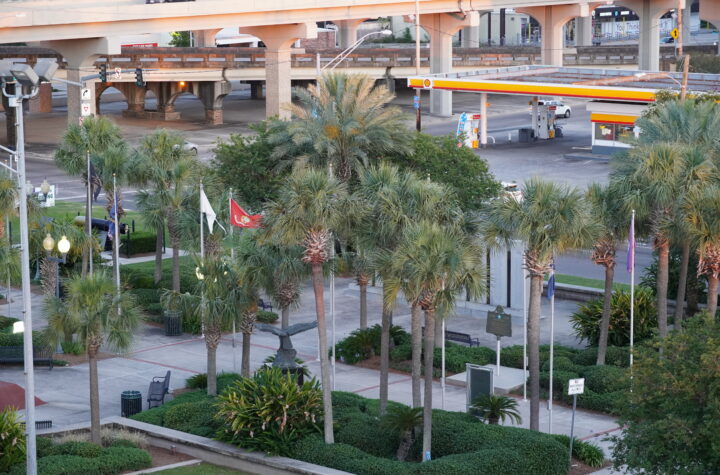
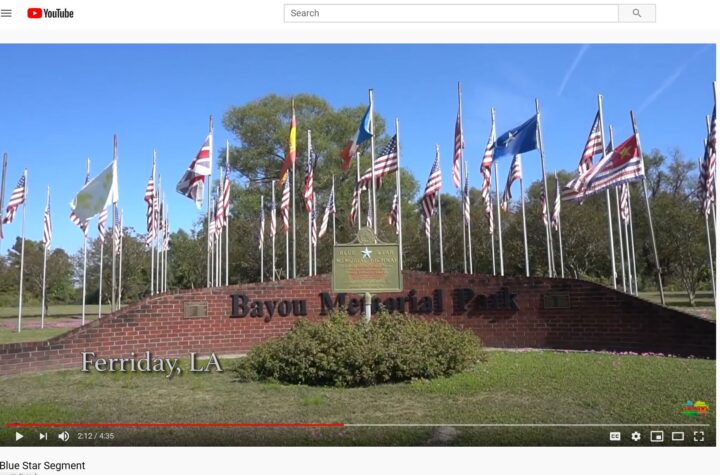
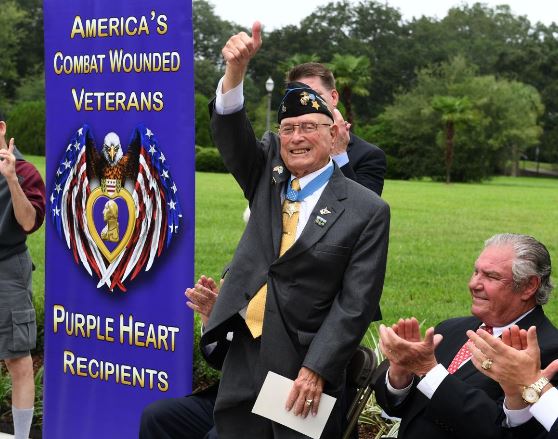
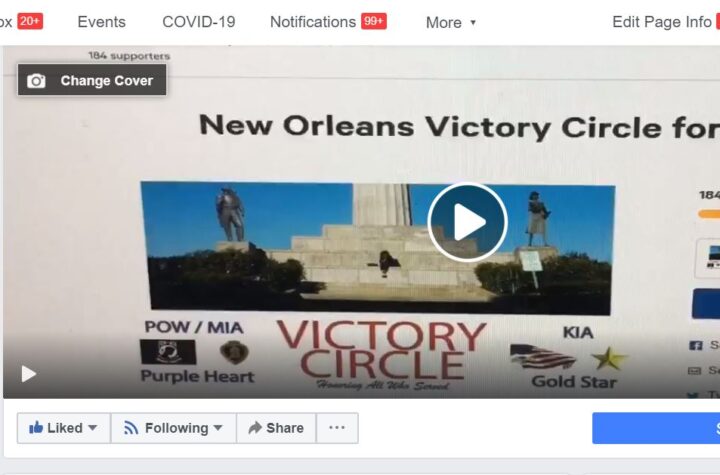
More Stories
Annual Days Honoring Armed Services at Victory Circle
Victory Circle Facebook Page
Support Victory Circle Idea with T-shirts & Petition